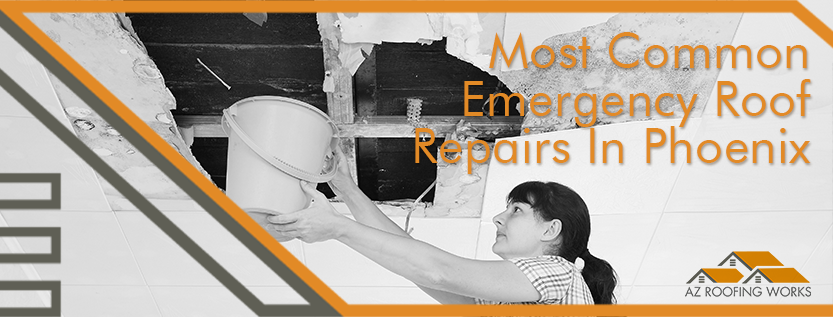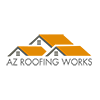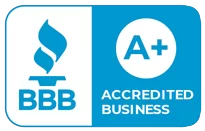Most Common Emergency Roof Repairs in Phoenix and How to Avoid Them
Extreme weather, inferior roofing materials, and unprofessional installation can cause havoc on residential roofs throughout the Phoenix Valley. Whether you have a tile, shingle, or flat roof, discovering roofing damage can cause frustration and put a pretty solid dent in your pocket-book. While each type of roof is different, there
In the information posted below, we’ll explain the most popular types of roofs in Arizona, dive into the top 20 most common emergency roof repairs in Phoenix, and what you can do to reduce the potential of damage and extend the lifespan of your home’s roof.
What is an Emergency Roof Repair?
The intent of any residential property, be it a single-family home, duplex, or apartment complex is to provide shelter from outside elements. Since outdoor temperatures can eclipse 100-degrees for more than half of the year, and unexpected rain showers can cause significant leaks, any damage to a roof should be considered an emergency situation. In many instances, minor damage to roofing materials, the roofing underlayment or flashing can quickly spread, potentially leading to a full roof replacement if not caught and resolved quickly. The bottom line – if you discover any damage to your roof, it should be considered an emergency home repair. So, contact a professional roofing repair company in Phoenix ASAP.
What are the Most Common Roof Styles in Phoenix?
Homes from Gilbert to Scottsdale have three general types of construction:
- Tile Roofing
- Shingle Roofing
- Flat/Foam Roofing
Each of these roof designs
Tile Roofing
A tile roof is arguably the most popular style of roof for homes throughout the Phoenix Valley. Tile roofs are comprised of an underlayment (which involves several layers of wood, plastics, and other materials that provide a solid base) and carefully and strategically placed tiles (which can be made from different materials depending on the type of tile roof on your home).
There are (4) main sources of tile roof damage here in the Phoenix valley:
- Erosion: Blowing sand and extreme winds experienced in the Phoenix Valley can cause some tile roof materials to wear thin. When they are damaged, they will likely require replacement to avoid damage to the underlayment. Replacing a few tiles quickly is much more affordable than complete roof replacement.
- Poor Construction: Installing tile roofing is a complex and detailed process. However, there are times when some roofing companies cut corners on installation procedures. Whether it is not carefully spacing each tile as recommended by the manufacturer, or using poor quality materials, poor construction procedures and materials are a leading source of roofing damage in Phoenix.
- Sliding or Cracked Tiles: Although tile roofs are quite solid, they can become cracked or shift for multiple reasons. If the roof is not repaired, or tiles replaced, it can expose the underlayment and lead to tiles become cracked either due to age or exposure to the elements, it can expose the underlayment and cause damage which can lead to leaks.
- Edging Damage: The roof edging is designed to protect the roof’s deck, underlayment, and other materials underneath the tiles. If the edging is damaged, excessive water damage can occur during monsoon season storms.
Shingle Roofing
Shingle roofs are more common among older residential properties. While they are usually more affordable and easier to repair than tile roofing, they are prone to more sources of roof damage.
Here are 7 of the most common sources of shingle roof damage:
- Curling or Buckled Shingles: Shingles are made from flexible materials that can literally buckle or warp when they become too hot.
- Cracked Shingles: Since they are flexible, they are also prone to drying due to excessive exposure to the sun and weather.
- Granule Loss: When shingles become aged the material of the shingle wears thin, the granules on top can loosen and wear off.
- Split Shingles: Another source of damage to shingle roofing materials is when they split.
- Exposed or Missing Nails: Shingles are secured to a roof via smaller yet rather thick nails. When the wind blows, it can cause shingles to loosen, which can expose nails and eventually fall out.
- Reduced Ventilation: A shingle roof includes carefully placed ventilation sources which allows air to flow in and out of the attic on a consistent basis. If the attic does not ventilate properly, it can damage the roof from underneath – leading to leaks.
- Missing Shingles: When shingles become loose, they can either fall of naturally or be blown off when the winds pick up.
Flat or Foam Roof Repair
Flat roofs and some of the materials used in its construction can be exceptionally energy efficient. Like tile and shingle roofing, there are several sources of roof damage which require emergency roof repair in Phoenix.
Here are (3) common sources of flat or foam roof damage:
- Edge Damage: The edging on a flat roof protects underlayers and foundation. When it’s bent or damaged, it can cause water to leak underneath or between underlayers.
- Ponding Water: Flat roofs are built with multiple points of drainage that helps to expedite the removal of standing water. If the drainage is blocked or when water pools in locations over time, it can cause membrane damage, leading to leaks or other sources of roof damage.
- Cracked Membrane: Overtime, the under membrane required on these types of roofs can wear thin, become torn or cracked and require repairs.
Other Sources of Emergency Roof Repair in Phoenix
The above examples of roof damage can be caused by natural wear and tear, exposure to elements, or other reasons you’d never consider. Here are a few of the most common causes of roof damage in the Phoenix Valley:
- Excessive Exposure to the Sun: It is estimated that Phoenix experiences more than 180 days with
the average temperature over 90 degrees. When temperatures can eclipse 110 for more than 90 days, this creates a significant amount of heat, which tends to accelerate the wear and tear of roofing materials. - Wind: We receive a lot of blowing wind in the desert. Some roofing materials such as shingle roofs are prone to damage due to blowing wind.
- Haboobs: The sand
storm, or haboob is an extreme weather situation that often occurs during the late summer monsoon season from July to September. This mixture of blowing sand, gusting wind and rain can cause havoc on any roof. - Down Trees: Another casualty of the summer monsoon season
are extreme thunderstorms, which can and often will uproot trees or cause larger limbs to fall on roofs and lead to damage. - Lightning Strikes: It’s estimated that the typical summertime thunderstorm in the Phoenix Valley will experience more than 1,000 individual cloud-to-ground lightning strikes. When this type of energy (1.21 gigawatts if you recall Dr. Brown’s scientific data from Back to the Future) hits a roof, it can cause significant damage from burns to severe cracks.
Damage from Animals: This type of damage is common with shingle roofs, as they are easy for squirrels, roof rats, birds, and other animals to tear, bite, claw, or remove via other sources. Animal waste from birds and others can also cause damage to waste due to the acids and ammonia’s found in waste byproduct.
What Can You Do to Avoid Emergency Roofing Repairs?
Like any other component of a home, a roof requires routine service and maintenance to keep them protected. Some of the simple things you can do to reduce the potential of damage to roofs and roofing materials includes the following four easy steps:
Inspect the Roof Every Year
Most roof damage is progressive in nature, meaning that materials slowly wear out, until they become damaged. By having a professional roofing company inspect your roof at least once per year, you can have minor issues resolved before major repairs are required.
Replace Missing Tiles & Shingles
If you are informed that minor damage to tiles or shingles exist on your roof, don’t delay. Make sure to have a professional roofing repair company in Phoenix replace any missing or damaged materials. If you discover damaged or missing roofing materials, don’t attempt to replace them yourself as all roof repairs should be completed by a professional and certified roofing company.
Do Not Power Wash a Roof or Flashing
While it is a rather easy way of cleaning a home exterior, power washing a roof can have horrible consequences. High-pressure washing can force water beneath the roofing materials, leading to damage to the underlayment, causing water damage, and eventually lead to full roof replacement. If you have shingle roofs and use a high-pressure power washer, you will pressure wash layers of your roofing material off, essentially taking years of your roof.
Trim Nearby Trees
We indicated above that falling trees and limbs are a major source of emergency roof repairs. Even branches that brush up against a roof or the side of the house can cause damage to roofing materials. To reduce the potential of damage, make sure they are trimmed frequently.
The best tip for avoiding emergency roofing repairs is to contact a professional roof repair company in Phoenix anytime you suspect damage. An experienced and trustworthy roofing repair company like AZ Roofing Works which has experience completing repairs of any size (and replacement if needed), and on any residential or light-commercial style of roof.
If you are dealing with a roof issue or you’re concerned a roof problem is on the horizon, reach out to the team at AZ Roofing Works! We will send one of our roofing professionals to your home so you can Get a FREE Roof Estimate. Call our office at (602) 283-3383 or submit a Free Roof Estimate request online here.
Related Blogs:
- Ultimate Guide to Roof Replacements in Arizona
- How Long Does a Tile Roof Last in Arizona?
- 6 Signs You Need Shingle Roof Repair Fast






